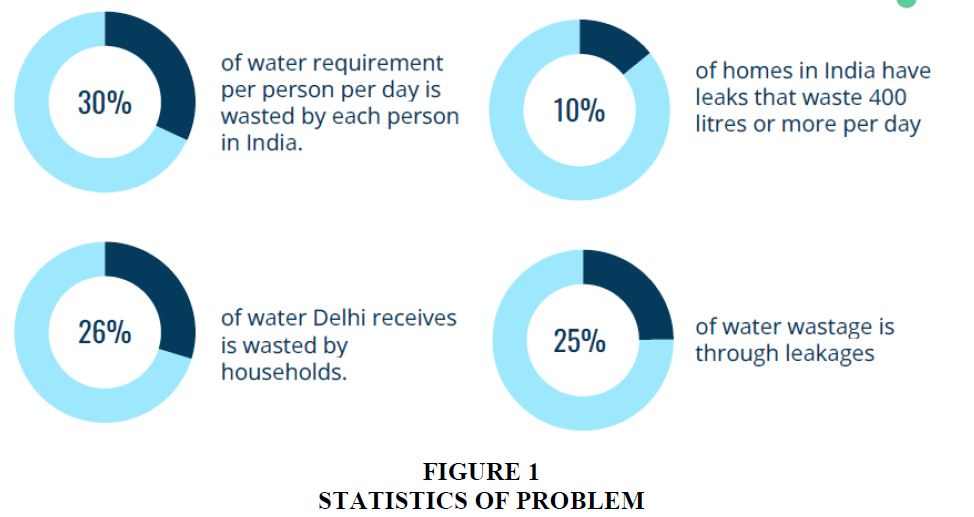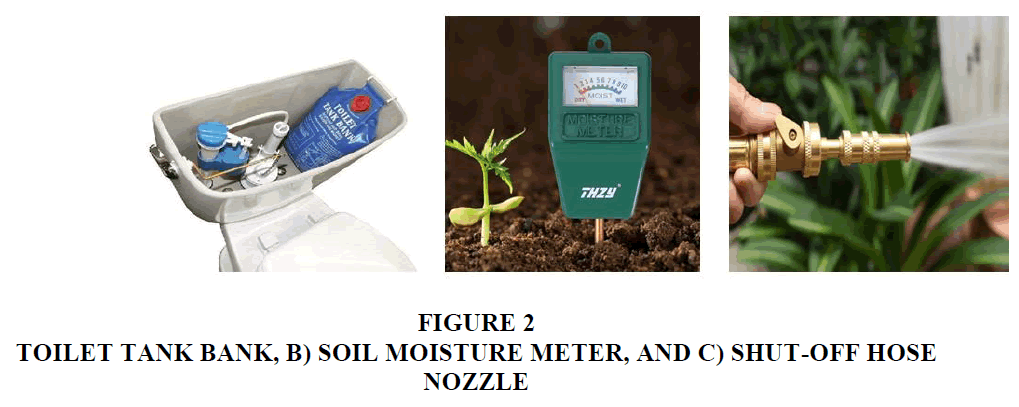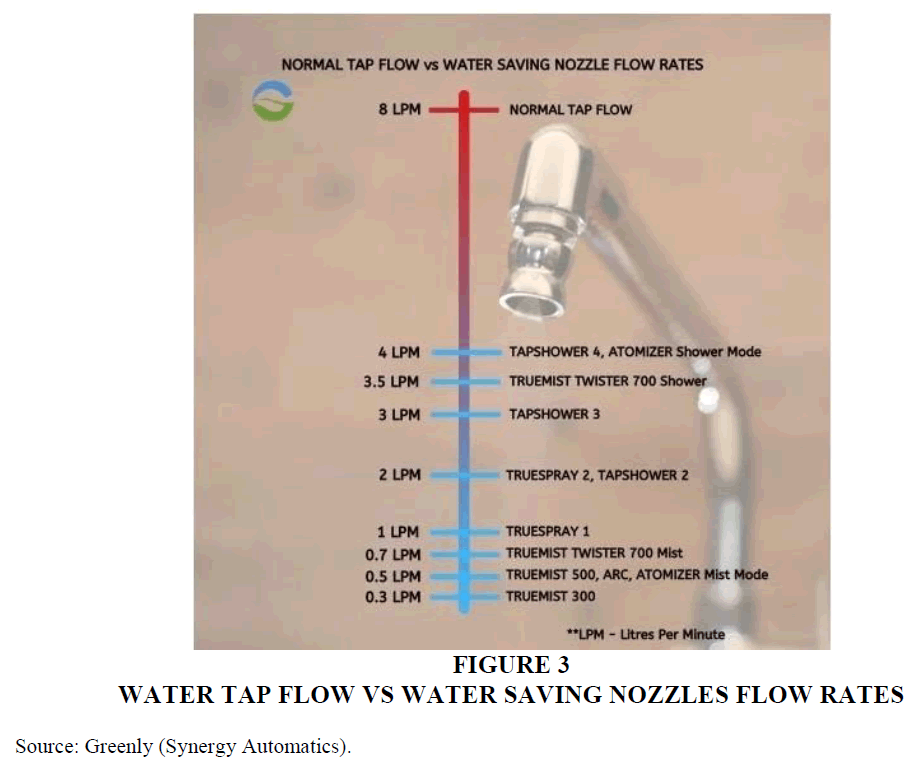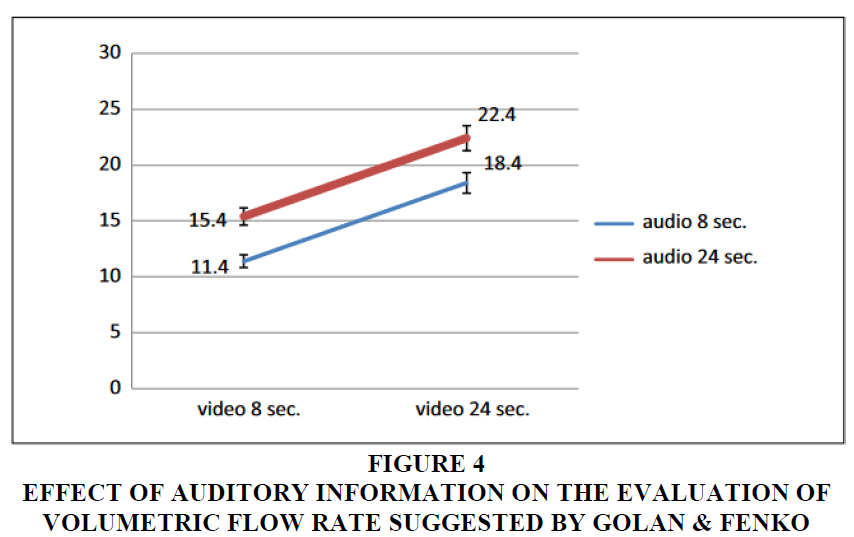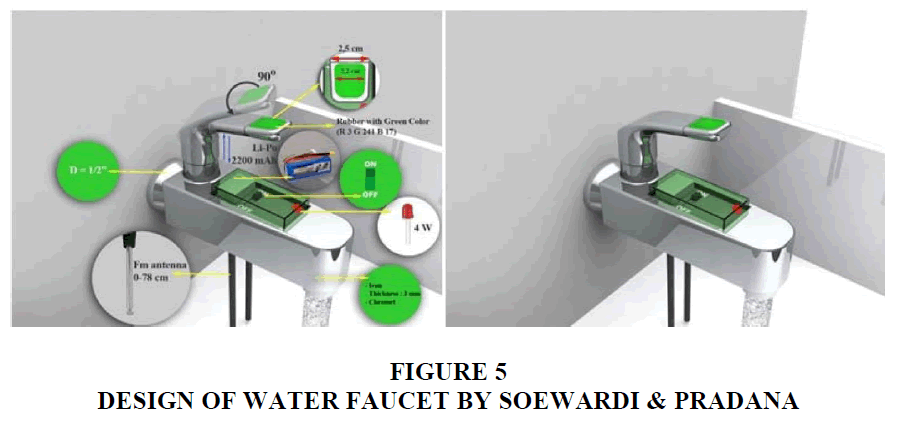Research Article: 2024 Vol: 28 Issue: 4
Water Conservation Faucet Attachment
Diya Singhal, Shodh Sagar Research Institute
Aanya Jain, Shodh Sagar Research Institute
Citation Information: Singhal, D., & Jain, A. (2024). Water conservation faucet attachment. Academy of Marketing Studies Journal, 28(4), 1-11.
Abstract
Background: Water conservation is of utmost importance in addressing the increasing global demand for freshwater. In this context, water conservation faucet attachments have emerged as a promising solution to minimize water wastage during everyday activities. Objective: This research paper aims to study and evaluate existing research and designs related to water conservation faucet attachments in order to identify an optimal design for implementation. The objective is to explore flow control mechanisms, aerators, sensor technologies, and user behavior analysis to determine their effectiveness in conserving water. Findings: Through an extensive review of previous studies and designs, this research paper presents a comprehensive understanding of water conservation faucet attachments. The analysis reveals the strengths and limitations of various designs, considering factors such as water savings, user satisfaction, and overall efficiency. Key findings include the importance of easy installation, compatibility with existing faucets, and cost-effectiveness in promoting widespread adoption. Conclusion: Based on the synthesis and analysis of existing research, a specific water conservation faucet attachment design is selected as the most optimal. This design showcases significant potential for water savings while ensuring user comfort and convenience. Recommendations for implementation, further research, and potential design improvements are also provided.
Keywords
Water Conservation, Faucet Attachment, Flow Control Mechanisms, Aerators, Sensor Technologies, User Behavior Analysis, Water Savings, User Satisfaction, Implementation, Research, Design Improvements.
Introduction
Water shortage is a looming worldwide catastrophe that must be addressed immediately. According to statistics, over 80% of the country anticipates water challenges in the next years. This anticipated scarcity of drinking water is one of the most important humanitarian issues confronting the globe today. Water shortage not only affects our everyday lives but also poses a danger to the ecosystem and incurs significant utility costs for multi-tenant landlords. Surprisingly, leaks account for more than 25% of residential water waste, resulting in an alarming loss of 400 liters per day.
Water is a priceless resource that is required in every area of life, from drinking and sanitation to agricultural and industrial activities. Water conservation is becoming increasingly important as the demand for water rises owing to population expansion and economic development. Individuals may make a big contribution to alleviating water shortage concerns by reducing their home water use. Water conservation offers several advantages. For starters, it provides a more equal allocation of water resources, particularly in areas experiencing acute water scarcity. Second, it relieves pressure on water supply systems by reducing over-extraction from natural sources including rivers, lakes, and aquifers. This, in turn, aids in the preservation of sensitive ecosystems and the maintenance of a healthy environmental balance. Conserving water not only has a positive environmental impact but also brings substantial financial benefits to individuals and communities, making it a smart and prudent choice in terms of cost savings.
Water waste, particularly leakage, not only adds to the shortage but also has negative environmental implications. The amount of water lost every day due to leaks is astonishing, estimated at 400 liters per home. Such waste exacerbates water shortage worries and adds to the already-strained water supplies. Furthermore, water waste has a considerable carbon burden. Water treatment, pumping, and distribution all require energy, which is frequently obtained from fossil fuel sources. When water is wastefully wasted, energy is lost, resulting in unnecessary greenhouse gas emissions. We can reduce our carbon footprint and help the battle against climate change by minimizing water waste.
Furthermore, the negative impact of water waste on ecosystems cannot be understated. Water overuse and loss undermine the natural equilibrium of aquatic environments. Reduced water levels influence the survival of varied flora and wildlife in rivers, lakes, and wetlands. Water conservation through responsible consumption practices helps to protect these fragile ecosystems and biodiversity Figures 1-5.
Figure 4 Effect of Auditory Information on the Evaluation of Volumetric Flow Rate Suggested by Golan & Fenko
Household leakages make for a significant share of water waste, accounting for more than 25% of total usage. To address this issue, proactive efforts must be taken to detect and repair leaks as soon as possible. Regular examination and maintenance of plumbing systems can aid in the detection and repair of leaks. Water-saving fixtures, such as low-flow faucets, toilets, and showerheads, may greatly cut water use. Furthermore, increasing public knowledge of the need for leak detection and repair can result in behavioral changes that promote a water-saving culture. Furthermore, technical improvements have enabled the development of smart water management systems capable of detecting leaks and monitoring water consumption in real-time. These systems use sensors and data analytics to give significant insights into households' water consumption patterns. Individuals may take proactive efforts to remedy leaks and preserve water by using such advancements Arduino, (2021).
Water shortage needs a collective effort on the part of governments, communities, and people. Water conservation policies and regulations are enacted and enforced by governments. Incentives and rebates can be implemented to encourage individuals and organizations to adopt water-saving practices and technology. Furthermore, governments may invest in infrastructure upgrades such as improving aging water distribution systems and encouraging the use of reclaimed water for non-potable applications such as agriculture Berk et al. (1993).
Collaborative efforts among diverse stakeholders are required to achieve a collective impact. Water conservation may be promoted by non-governmental organizations (NGOs), community groups, and educational institutions through campaigns, seminars, and instructional programs. Engaging with local communities and allowing people to take ownership of their water consumption helps promote a sense of responsibility for sustainable water practices. As a result, the present project concentrates on building a tap attachment to promote sustainable water usage, reduce waste, change user behavior, and have a good influence on both the environment and individuals' finances Bogdan et al. (2023).
The objective of this research paper is to explore and evaluate existing studies and designs related to water conservation faucet attachments. By conducting a comprehensive review of previous research, we aim to identify an optimal design for implementation, considering factors such as water savings, user satisfaction, and overall efficiency. The findings of this research will contribute to the advancement of water conservation practices and provide valuable insights for designers, manufacturers, and policymakers Di Nonno, & Ulber (2022).
In this paper, we will delve into various aspects of water conservation faucet attachments, including flow control mechanisms and user behavior analysis. We will examine the methodologies, findings, and limitations of previous studies, providing a comprehensive overview of the current state of research in this field. Additionally, we will analyze different design approaches employed in the development of water conservation faucet attachments, considering factors such as ease of installation, compatibility with existing faucets, durability, and cost-effectiveness Dutta et al. (2016).
Existing Solutions for Water Conservation
On the market, there are multiple water conservation gadgets meant to enhance water efficiency and sustainable practices in various situations. Individuals may contribute to water conservation initiatives and minimize wasteful water consumption by utilizing them, resulting in economic savings and environmental advantages. Here are a few examples:
• Toilet Tank Bank: A toilet tank bank, also known as a toilet displacement device or a toilet tank insert, is a straightforward water-saving device that may be installed within the toilet tank. It is usually made up of a plastic bag or container filled with water or other items (such as pebbles or sand) that are used to displace part of the water in the tank. Each flush consumes less water while still effectively flushing waste by lowering the volume of water in the tank. Toilet tank banks are inexpensive and simple to install, requiring no special equipment or plumbing changes. They are intended to save water in toilets while remaining functional .
• Soil Moisture Meter: A soil moisture meter is a device that measures the moisture content of the soil in gardening and landscaping. It generally consists of a probe placed into the ground to determine the moisture level of the soil. Gardeners can correctly estimate when to water their plants by utilizing a soil moisture meter, eliminating overwatering or underwatering. This conserves water by ensuring that plants only receive the quantity of water they require based on the moisture level of the soil. Soil moisture meters come in a variety of styles, including analog and digital models, and are popular among both professional landscapers and home gardeners.
• Shut-off Hose Nozzle: A shut-off hose nozzle is a garden hose attachment that may be attached at the end of the hose. It enables the user to control the flow of water by simply turning the nozzle on and off. This function is very helpful when switching between watering activities or momentarily halting the flow of water without turning off the tap. Water waste may be reduced by employing a shut-off hose nozzle, which gives simple control over the water flow. When not actively utilizing the hose, users can modify the water flow to match their needs. Shut-off hose nozzles are often affordable, simple to install, and work with the majority of common garden hoses.
Limitations of Available Devices
Although existing devices, such as sprinkler heads, faucet aerators, soil moisture sensors, and toilet tank banks, are in the market aimed at water conservation, they are perceived as not being cost-efficient or sustainable, particularly in the context of India. Let's delve into the reasons behind this perception:
• Cost: One of the main concerns is the initial cost of these devices. If the price of a water conservation device is too high, it may deter individuals, especially in regions with limited financial resources, from purchasing and installing them. Affordability is a crucial factor in promoting widespread adoption.
• Maintenance: The statement mentions that the maintenance for these devices is high. This aspect refers to the effort, time, and expenses required to keep the devices in good working condition. If the maintenance demands are excessive or if specialized knowledge or spare parts are needed, it can discourage people from using them.
• Compatibility: Another aspect to consider is the compatibility of these devices with existing infrastructure. In the case of faucet aerators or sprinkler heads, for example, it's essential to ensure that the devices can be easily installed on various types of faucets or sprinkler systems commonly found in households or public spaces. Lack of compatibility can limit their usability.
• Effectiveness: Perception of effectiveness is crucial for user acceptance. If the water conservation devices do not deliver noticeable results or fail to meet expectations, people may be reluctant to invest in them. Demonstrating clear benefits and providing evidence of water savings are essential to convince individuals of the devices' efficacy.
• Awareness and Education: Lack of awareness and knowledge about the devices and their benefits can be a significant barrier to adoption. Without understanding how these devices work or the potential savings they offer, people may not recognize their value and overlook their installation.
• Cultural and Social Factors: Cultural and social factors can influence the acceptance and adoption of new technologies or devices. Factors such as trust in traditional methods, skepticism towards unfamiliar technologies, or social norms can all impact the willingness of individuals to install and use these devices.
To address these challenges, it is important to develop cost-efficient and sustainable water conservation devices that consider the specific needs and constraints of the target market. This involves conducting research and development to reduce costs, improve durability, simplify installation and maintenance processes, and raise awareness about the benefits and effectiveness of the devices through educational campaigns and community engagement.
Water Conservation Faucet Attachments and their Benefits
A water conservation faucet attachment, also known as a faucet aerator or flow restrictor, is a device that may be connected to the end of a faucet to lower the flow of water and conserve water. It is often made out of a tiny metal or plastic mesh screen that mixes air with the water stream, lowering the volume of water that runs through the tap while keeping a consistent and pleasant flow. Standard Tap Aerators will not restrict the flow of water, and the water flow is directly proportional to the pressure of the waterline. So, Standard Aerator dispenses anywhere between 8 liters per minute to 15 liters per minute. The primary goal of a water conservation faucet attachment is to reduce water waste while maintaining the faucet's functioning. Water Saving Tap Nozzles divides the flow of water into multiple small streams by adding air in between or changing the stream into different formats. As a result, the volume of water flowing from the tap gets appreciably reduced as the water stream is diluted with air. These results in water savings as well as minimize splashing in sinks. These accessories may drastically reduce the quantity of water needed for routine chores like washing hands, brushing teeth, and rinsing dishes by injecting air into the water stream. Faucet attachments often come with variable flow rates, allowing customers to determine the appropriate amount of water saving. A conventional tap, for example, may have a flow rate of roughly 2.2 GPM, whereas a water conservation attachment can reduce it to 1.5 GPM or even lower, depending on the type Gabarda-Mallorquí et al. (2018); Golan & Fenko, (2015); Han et al. (2020).
Using a water conservation faucet attachment has several benefits, including:
• Water conservation: By lowering water flow, these attachments can help preserve water, which is especially significant in locations where water is scarce or when there is a drought. They improve water conservation without jeopardizing everyday demands.
• Energy savings: Because less hot water is utilized, the amount of energy necessary to heat the water is lowered. This can lead to cheaper energy costs and fewer negative environmental effects.
• Cost savings: Water conservation results in decreased water bills over time. Households and businesses may save money on their water bills by installing a water conservation tap attachment.
• Environmental impact: By reducing water use, these attachments assist in preserving water resources and conserve ecosystems that rely on appropriate water supply.
Installing a water conservation faucet attachment is usually simple and may be done without the aid of a professional. Many accessories simply screw onto the spout of the tap or replace the current aerator. They come in a variety of diameters to accommodate various types of faucets. It's worth mentioning that some modern faucets include water-saving features like flow restrictors or adjustable flow rates. If your tap lacks these qualities, putting a water conservation tap adapter is an easy and inexpensive approach to conserve water and encourage sustainable living.
Development of a Faucet Attachment with its Features and Components
The project's goal was to provide an innovative solution that uses Internet of Things (IoT) technology to control water flow through taps. Our gadget is simple to install on existing taps and provides a ground-breaking method to water saving and monitoring. We hope to optimize water flow and increase water-saving capacities by using our solution Katz et al. (2016); Koop et al. (2019).
Features of faucet attachment
The ability of our gadget to manage water flow by easily connecting to any ordinary tap is its defining feature Lupinski et al. (2021). This enables us to introduce H2Optimize, a system that regulates and controls the flow of water intelligently. We can drastically minimize waste and encourage sustainable water consumption practices by optimizing water utilization.
The implementation of gesture-based control is one of our solution's distinguishing features. Users may now easily change the pace at which water is delivered by executing a swipe motion near an infrared sensor. This novel interaction mechanism not only delivers a user-friendly experience but also helps to touch-free operation, which is very important in the current health crisis when hygiene and sanitation are critical Marinoski et al. (2018); Shao et al. (2019).
To guarantee proper flow regulation, our project intends to link our gadget to water taps in both residential and commercial settings. Our technology can detect the presence of hands using sophisticated sensors, prompting the activation of specially designed nozzles that atomize the water stream. This atomization method reduces water consumption while still providing an excellent user experience Sudeep et al. (2020).
In addition to our IoT-integrated hardware, we have created a specialized mobile application that acts as the device's control center. Our solution's IoT components effortlessly link to the app, allowing customers to conveniently monitor and manage their water use. The app captures detailed data about water use, which can then be analyzed for important insights and research. Our system supports not just sustainable water consumption but also data-driven water management by utilizing IoT technologies. We can get useful information on water usage patterns and trends thanks to the integration of smart devices and networking. This information can assist people, companies, and policymakers in making educated decisions and putting in place effective water conservation initiatives.
The Internet of Things-enabled gadget for managing water flow through taps transforms how we consume and manage water. We provide consumers with a smooth and sustainable water conservation solution for both personal and commercial usage by integrating innovative technology, touch-free operation, and data-driven insights. Arduino provides several benefits by allowing the incorporation of extra elements into electrical projects. One key advantage is the ability to connect to the Internet of Things (IoT) with ease. By combining Arduino with IoT technology, projects may interface with other devices and systems through the internet, allowing for remote control, data sharing, and automation.
Components of Faucet Attachment
The ESP8266, a tiny and low-cost microcontroller that is generally compatible with IoT interfaces, notably through Wi-Fi connectivity, is a critical component of our project. This enables our gadget to exchange data over the network and effortlessly connect with current IoT systems. It is now possible to add IoT features such as wireless networking through Wi-Fi or Bluetooth modules with Arduino. This allows projects to interface with internet platforms, cloud services, and mobile apps in real-time, allowing for real-time monitoring, control, and data analysis. For example, in the context of water conservation, Arduino may help with data collection and monitoring, offering useful insights for analysis and optimization. Furthermore, the adaptability of Arduino enables the use of other sensors and actuators to improve project functionality. Users may add sensors for detecting water flow rates, humidity levels, or soil moisture, among other things, by leveraging the vast variety of compatible components. This information may be analyzed and utilized to trigger particular actions or modifications, resulting in more effective water management and conservation. The programming freedom of Arduino, as well as its expanded hardware ecosystem, makes it easier to integrate new features and capabilities. Users may quickly write code to control and synchronize several components, allowing for sophisticated behaviors and interactions. This adaptability allows producers to modify their work to unique demands and investigate novel solutions in areas such as water conservation and management.
We used an infrared sensor to provide automated control and user interaction. To detect adjacent things, this electrical gadget produces infrared (IR) light. In our project, we use the infrared sensor to automate duties like selecting the water flow mode and triggering the solenoid valve. Users may operate and alter the device's functionality without making physical touch by recognizing gestures or hand motions near the sensor.
A servo motor has been added to our design to produce accurate and controlled rotational motions. The servo motor is a type of motor that is distinguished by its precise and controlled rotation at certain angles or distances. To engage the aerator's mode, we used the Tower-Pro SG 90 Micro Servo Motor as the primary actuator in our project. This allows us to precisely obtain the required water flow pattern or modification. Our project provides a comprehensive solution for managing water flow through taps by combining the tiny and adaptable ESP8266 microcontroller, the IR sensor for automation and gesture-based control, and the precise rotating capabilities of the servo motor. These components collaborate to deliver effective and user-friendly water usage control while using IoT connectivity for expanded functionality and data sharing.
The water flow sensor is another critical component of our research. This sensor is critical in properly detecting the rate of water flow, allowing us to monitor and measure the amount of water supplied and used. We can accurately determine the volume of water that goes through the system by putting the water flow sensor at the water source or within pipes. Water flow rates are often quantified using measurement units such as liters per hour or cubic meters.
We concentrated on programming an existing aerator as part of our optimization and development approach. An aerator is a piece of equipment that is typically used with taps to regulate and shape the water stream that comes out of the tap spout. Its major function is to reduce splashing by directing water in a smooth and regulated flow. We can assure an effective water stream with minimal water dispersion by optimizing the aerator's functionality. Furthermore, the aerator helps to stabilize the water pressure, which results in extra water conservation benefits.
We can precisely detect the water flow rate and make real-time modifications to optimize water use by combining the water flow sensor with the aerator's programming. This link allows us to deliver precise statistics on water use and perform efficient water-saving programs. Our concept provides a comprehensive solution for monitoring and managing water flow by combining the water flow sensor and improving the operation of the aerator. This not only promotes optimal water use but also helps to reduce water waste and promote sustainable practices.
We used a bistable valve, which is a sort of unidirectional bistable electromagnetic valve, in our project. By putting an electric current across it, this valve may be switched between two resting states, namely the "on" and "off" positions. We can successfully regulate the flow of water by toggling the valve between these two states by using this component. This enables us to switch the gadget on and off as needed.
We used a Lipo (Lithium Polymer) 3.7V battery and a 5V step-up module to guarantee a continuous power supply for the circuit. The major power source is a Lipo battery with a value of 3.7V. The 5V step-up module, also known as an adjustable booster power supply module, is used to raise the voltage from the battery to the 5V necessary to power our device's electronics. This setting guarantees a consistent power supply to all components and allows the gadget to work properly.
Our prototype displays efficient control over water flow while maintaining a dependable and regulated power source by combining the bistable valve for water flow control and the Lipo battery with the 5V step-up module for power supply. This integration enables the gadget to operate seamlessly and consistently throughout its lifetime.
Conclusion
In conclusion, the selected studies offer valuable insights into different aspects of water conservation faucet designs, addressing various challenges and incorporating innovative features. Each study brings unique contributions to the field of water conservation, and their findings can guide the development of optimal faucet attachments for sustainable water usage.
The usage of our equipment provides consumers with the useful opportunity to receive daily information on their water consumption. These figures are critical in assisting decision-makers in prioritizing and carrying out efficient water conservation activities. Decision-makers may make educated decisions about water distribution and conservation measures by analyzing trends and patterns in water consumption and availability. Water managers may examine the present health of water resources and identify locations where conservation actions can have the most impact now that detailed information on water usage is available. They may make well-informed decisions to optimize water consumption, reduce water shortages, and protect this valuable resource for future generations if they have correct data and insights.
Furthermore, the distribution of these reports promotes enhanced water awareness among consumers and the general public. Water awareness campaigns may successfully communicate the importance of water conservation and the urgent need for collective action by providing statistics and numbers in a straightforward and accessible manner. Individuals are empowered to comprehend their water use habits when data is visualized, supporting appropriate water usage practices on an individual basis. The application of statistics and data-driven insights improves the efficacy of water conservation programs and initiatives. It enables the identification of high-impact locations, provides targeted messaging, and encourages a better awareness of the necessity of water resource conservation. Communities may use this knowledge to band together to execute collective actions, adopt sustainable practices, and contribute to the broader objective of protecting water resources for a sustainable future.
Finally, the provision of daily water use figures by our gadget enables decision-makers, water managers, and communities to prioritize and implement efficient water conservation activities. We can raise awareness, encourage responsible water use, and motivate collective action to preserve this essential resource for future generations by using statistics and numbers in a straightforward and accessible manner. Let us accept the duty of protecting this valuable resource and ensuring a flourishing world for all.
Future Scope
By addressing the critical issue of water conservation at the individual level, water conservation faucet attachments offer a practical and effective means of reducing water consumption. The findings of this research paper will contribute to the broader objective of achieving sustainable water management and conservation, helping to preserve this invaluable resource for future generations.
Figure 4 Effect of Auditory Information on the Evaluation of Volumetric Flow Rate Suggested by Golan & Fenko
References
Arduino, M. J. (2021). Tap Water Avoidance Decreases Rates of Hospital-onset Pulmonary Nontuberculous Mycobacteria: A Call for Water Management in Healthcare. Clinical infectious diseases: an official publication of the Infectious Diseases Society of America, 73(3), 528.
Indexed at, Google Scholar, Cross Ref
Berk, R. A., Schulman, D., McKeever, M., & Freeman, H. E. (1993). Measuring the impact of water conservation campaigns in California. Climatic Change, 24(3), 233–248.
Indexed at, Google Scholar, Cross Ref
Bogdan, R., Paliuc, C., Crisan-Vida, M., Nimara, S., & Barmayoun, D. (2023). Low-Cost Internet-of-Things Water-Quality Monitoring System for Rural Areas. Sensors, 23(8), 3919.
Indexed at, Google Scholar, Cross Ref
Di Nonno, S., & Ulber, R. (2022). Portuino—A Novel Portable Low-Cost Arduino-Based Photo-and Fluorimeter. Sensors, 22(20), 7916.
Indexed at, Google Scholar, Cross Ref
Dutta, P., & Dontiboyina, U. S. G. V. (2016). Faucet add-on water supply management system using smart sensors. In 2016 Second International Conference on Computational Intelligence & Communication Technology (CICT) (pp. 468-471). IEEE.
Indexed at, Google Scholar, Cross Ref
Gabarda-Mallorquí, A., Fraguell, R., & Ribas, A. (2018). Exploring Environmental Awareness and Behavior among Guests at Hotels That Apply Water-Saving Measures. Sustainability, 10(5), 1305.
Indexed at, Google Scholar, Cross Ref
Golan, A., & Fenko, A. (2015). Toward a Sustainable Faucet Design: Effects of Sound and Vision on Perception of Running Water. Environment and Behavior, 47(1), 85–101.
Indexed at, Google Scholar, Cross Ref
Han, H., Chua, B.-L., & Hyun, S. S. (2020). Eliciting customers’ waste reduction and water saving behaviors at a hotel. International Journal of Hospitality Management, 87, 102386.
Indexed at, Google Scholar, Cross Ref
Katz, D., Grinstein, A., Kronrod, A., & Nisan, U. (2016). Evaluating the effectiveness of a water conservation campaign: Combining experimental and field methods. Journal of Environmental Management, 180, 335–343.
Indexed at, Google Scholar, Cross Ref
Koop, S. H. A., Van Dorssen, A. J., & Brouwer, S. (2019). Enhancing domestic water conservation behaviour: A review of empirical studies on influencing tactics. Journal of Environmental Management, 247, 867–876.
Indexed at, Google Scholar, Cross Ref
Lupinski T, Ludwig M, Fraden S, Tompkins N. (2021) An Arduino-based constant pressure fluid pump. Eur Phys J E Soft Matter. 44(2):14.
Indexed at, Google Scholar, Cross Ref
Marinoski, A. K., Rupp, R. F., & Ghisi, E. (2018). Environmental benefit analysis of strategies for potable water savings in residential buildings. Journal of Environmental Management, 206, 28–39.
Indexed at, Google Scholar, Cross Ref
Shao Y, Li X, Zhang T, Chu S, Liu X. (2019) Time-Series-Based Leakage Detection Using Multiple Pressure Sensors in Water Distribution Systems. Sensors, 19(14):3070.
Indexed at, Google Scholar, Cross Ref
Sudeep N. Upadhe, Sanjeev C.Mhamane, Anant S.Kurhade, Prasad V. Bapat, Digvijay B.Dhavale, & Laxmikant J.Kore. (2020). Water Saving and Hygienic Faucet for Public Places in Developing Countries. Advanced Technologies for Societal Applications, 1, 617–624.
Indexed at, Google Scholar, Cross Ref
Received: 09-Nov-2023, Manuscript No. AMSJ-23-14175; Editor assigned: 10-Nov-2023, PreQC No. AMSJ-23-14175(PQ); Reviewed: 29-Jan-2024, QC No. AMSJ-23-14175; Revised: 15-Apr-2024, Manuscript No. AMSJ-23-14175(R); Published: 01-May-2024
